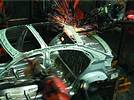BMW Group Vehicle Body Division takes CATIA V5 on-board
February 2004
Dr.-Ing. Matthias Engstler, Dipl.-Ing. (FH) Lorenz Rosenlehner Munich, Dr.-Ing. Thomas Löffler, Dipl.-Ing. (FH) Andreas Kempke Regensburg

In mid-2000 the BMW Group set up an internal programme to oversee the introduction of Version 5 of the CATIA CAD system. The evaluation of CATIA V5 made it clear that this was not merely a new version. This is a new generation of CAD system that is not only much more complex than CATIA V4 but has a different architecture and model assembly philosophy.
The main innovation in CATIA V5 is the association between different parameters in the model. This makes it possible to carry out modifications more simply, which can save a considerable amount of time. Moreover, the logical basis of the model construction process can be defined at any time. As this offers scope for improving its processes, the BMW Group decided to upgrade from CATIA V4 to V5. This article describes the new possibilities and the effects on processes associated with vehicle body production equipment.
In order to accelerate the development of a digital car, the BMW Group formed a partnership with Dassault Systèmes and IBM, so that the BMW Group's own requirements could be incorporated more easily into the software functionality. This partnership also made it easier to develop interfaces to existing software applications. A centralised project management was set up to ensure control over overlapping responsibilities.
The tasks of this project team cover the system architecture, support and development of universal model building methods that go beyond the process chains. In addition to this, specific methods for building models to meet the requirements of key users are being developed in individual disciplines.
New strategies and methods for building models
The association between different parameters in the models in CATIA V5 is seen by the project team as a challenge and a stimulus for creating new approaches, procedures and processes. In order to realise the potential of this innovation throughout the organisation, two strategies are being pursued in vehicle body technology: firstly, the development of modular systems, and secondly, optimising the parameters.
For modular systems, the models are built from modules using parameterised, standardised components. This procedure leads to a reduction in time and costs in building models as well as in fabrication. The detailed specification of the overall dimensions can be minimised and minimum cost fabrication processes can be developed for standard components.
The use of parameterised templates helps to achieve the aim of delaying the construction of the models as well as the fabrication and assembly of the plant to the last possible moment during the vehicle design process. This means that, when starting to build the fabrication equipment, the data relating to the vehicle body components is more accurate, which avoids having to rework or rebuild plant units that have already been installed. Moreover, re-using templates that only need to be built once reduces the number of components and limits the complexity of the model. Models are modified simply by substituting single elements or complete components.
This method helps the aim of using previously designed equipment as the basis for new models. However, it is not always possible simply to re-use standard or bought-in parts as these may also be subject to modifications and the newer versions cannot be used without further work. The second strategic aim is to optimise the parameters specifically for each application.
Depending on the expected frequency and predictability of the modifications to be made as well as on other external constraints, the most appropriate form of parameterisation must be determined and applied. For frequent, 'plannable' modifications, for example, knowledgeware can be used and adaptive and skeleton models can be used. In special cases where modifications are only required infrequently or re-use and modifications cannot be predicted, embedded parameters and assembly constraints can be used.
The modular standard robot mounting was one of the BMW Group's first standard parameterised models built using adapter techniques. This universal model is available to BMW Group suppliers in the form of a template. This template is integrated into their own models and can be adapted to various circumstances using the parameters. Using CATIA V5 can reduce the time taken just to build the robot mounting model by up to 40% compared with V4. CATIA V5 was first used live in various pilot projects that were carried out internally and with external suppliers. Adapter models played a very important role in these projects. The adaptive methodology, in particular, made it possible to have a clear overview of the model. As vehicle body plants are subject to modification over a period of some ten years, it is important that the structure of the model can be set up so that it can be clearly understood and above all that it is practical. Modifications to models are carried out internally by the BMW Group as well as by its suppliers.

Pilot projects use adaptive methodology
The model construction methodology is documented in a manual that is available to vehicle body technology suppliers together with the templates. Regular exchange of information is important to ensure the development of the methods. Initially V5 was used only for a few items of vehicle body equipment and components within pilot projects, since the beginning of 2002 all new developments of standard vehicle body equipment have been carried out using CATIA V5.
As well as technical costs, for example, ensuring that the BMW Group and its suppliers have the same CATIA system environment, experienced CATIA V4 users are initially reluctant to change as the modelling cost appears to be higher than for CATIA V4. The time taken to build a model has so far been greater for all V5 pilot projects than for comparable V4 projects. This could, however, be due to the fact that users had no V5 experience before the start of the project. The authors believe that a trained V5 user can produce a dedicated model that does not use any templates in the same time as using V4.

Training CATIA users must not be neglected
For each user, upgrading from CATIA V4 to V5 entails a significant training effort. As training courses are currently attended mainly by users who have experience of a CATIA V4 environment, particular emphasis will be placed on the recommended methods which the participants learn using sample models for vehicle body manufacturing equipment.
Most participants do not have any great difficulty in understanding how CATIA V5 creates a cylinder, for example, as 3D modelling is similar in many applications. What really causes a problem is that users have to think in a different way for V5 models because of the adaptive methodology and the parameters to be set up. The links in the model must be identified right at the start so that consideration can be given at an early stage to where modifications may be required. The references required for this, such as points, axes and planes, then have to be defined in the specification tree.
This model construction method, in particular setting up specification trees, cannot be fully learnt during a training course, but must be assimilated over a longer period. In general, a 10-day training course is not long enough to attain a knowledge of V5 that is comparable with the level of knowledge of V4 that has been built up over many years. When the project started in late 2000 the cost of upgrading to CATIA V5 was estimated as being lower than it is now. In the meantime, one engineer has been working exclusively on introducing V5 at each vehicle body technology site. A second engineer is assigned for providing methods support for suppliers who are using V5 for modelling.
The investment required by technical suppliers should also not be underestimated. This is mainly accounted for by the time required for training and by the implementation of V5 model construction methods, but they also have to provide the infrastructure and adapt individual applications to CATIA V5. For fabricating production equipment, there are still some obstacles to the general adoption of CATIA V5. The main problem is using a PDM system to handle CAD data for equipment that has complex structures with many layers of nested assemblies and individual parts. However, a major advantage of CATIA V5 is in its ability to manage whole assemblies or products using specification trees.
Long term goals and current obstacles
When managing whole assemblies, however, relations are created that go beyond the components. It is no longer possible to manage these links consistently in a PDM system while allowing for the possibility of new versions and the structure of the BMW Group's own PRISMA database. The methods that must be used for version management, therefore, lead to redundant data blocks, thus increasing the volume of data to be archived.
There is also potential for improvement of data transfer with suppliers, where complex product structures are being created without either a data management system or a user-friendly PDM system which then have to be imported into the BMW Group's PDM system. The data transfer must be secured in both directions.
One of the current aims is, therefore, to create a system environment with a consistent database to allow generalised linking of structures, thus leading to smaller data packets and generalised associative linking. The aim is to achieve electronic data interchange between the BMW Group and its suppliers without requiring a synchronised PDM system environment.
Furthermore, functional optimisations are being developed to automate time-consuming routine tasks and construction time. Finally, an integrated V5 process incorporating all relevant systems and tools must be set up, either by creating optimised interfaces or by replacing them with built-in V5 functions. If the above-mentioned obstacles can be overcome, it will then be possible to create an all-embracing productive environment.
Parameterisation methods for modelling using CATIA V5
From the point of view of a CATIA V4 user, the simplest option for changing over to CATIA V5 is to use V4 modelling methods in V5. No explicit parameterisation is required: the parameterisation produced automatically by V5 is used. An assembly is created from individual parts without using assembly constraints. One part, therefore, has no influence on the position or geometry of other parts. As shown in Diagram 1, a modification to the blue block leads to an assembly that is no longer valid as the blue and green blocks interfere.

A more advanced approach is to position the modelled parts next to each other (Diagram 2) with assembly constraints. This means that one part can influence the position of other parts without affecting their geometry. Modifying the blue block changes the position of the green and yellow blocks.

Going further (Diagram 3), it is possible to use parameters that influence more than a single part. This means that each part can control the position and geometry of other parts. In this example, increasing the size of the blue block reduces the size of the green block but has no effect on the position or geometry of the yellow block.

The most advanced approach is to structure the overall parameterisation by incorporating adapter models (Diagram 4). This means that the position and geometry of each part can be controlled exclusively using an adapter built using wireframe, in this case planes. Moving the next to bottom plane changes the size of the blue and green blocks.

For more information contact local CATIA representative, Igal Filipovski, CDC (CNC Design Consultants), 011 786 3516, igal@cdcza.co.za or www.cdcza.co.za
Others who read this also read these articles
The high-end MCAD and cPDm market segments of the PLM strategy
CIMdata considers the high-end MCAD market to include only those few CAD solution providers that deliver very comprehensive computer-aided design and analysis capabilities that are also tightly integrated with an enterprise-capable cPDm solution from the same supplier[ December 2005 ]
SA's prototype designers awarded
The SABS Design Institute is the driving force behind design promotion in the country through various award schemes, supporting innovation and entrepreneurship[ October 2005 ]
2D to 3D: the path to better products, faster and cheaper
Modern 3D CAD systems allow designers and engineers to edit a few parameters and automatically create the downstream deliverables for unique variants in minutes, instead of days or weeks[ October 2005 ]
ECL in Africa
ECL ensures a worldwide coverage of its client base through local service units which incorporate all the ECL know-how[ August 2005 ]
Catia brings business to South Africa
The fact that the A400M contracts were awarded to local enterprises is a strategic breakthrough for the South African aerospace industry[ August 2005 ]
Strand7 analyses the Beijing Water Cube
The latest Strand7 Release 2.3 has added the capability to take site specific seismic time histories and simply create equivalent spectral curves[ June 2005 ]
Pro/E versus SolidWorks
In summary, SolidWorks' swept surfaces and solids are more limited in their capabilities than Pro/Engineer's[ June 2005 ]
Northern Railway Extension receives green light
Windhoek Consulting Engineers was appointed as consulting engineers for the Northern Railway Extension, responsible for all aspects regarding the design and construction supervision of the total project valued at N$ 1,4 billion[ April 2005 ]
Others who read this also read these news items
Digitising a standard racing engine provides a springboard for future improvements
[ December 2005 ]
Nelson Mandela Metropolitan University leads the way with Catia V5
[ December 2005 ]
Integrated CNC solution for SA tooling industry
[ December 2005 ]
Accelerated design at Donkin Fans
[ December 2005 ]
PGF transforms its vision into reality
[ December 2005 ]
Defy introduces new product range
[ October 2005 ]
New Smarts for legal eagles
[ October 2005, Cadshop ]
Vectorworks scores with architects on ease of use
[ October 2005 ]
Others who read this also read these regulars
Search Site
Subscribe
Previous Issues
Other Technews Publications
Other Technews Buyers Guides
 |  | Copyright c1995-2009 Technews Publishing (Pty) Ltd.. All rights reserved. |